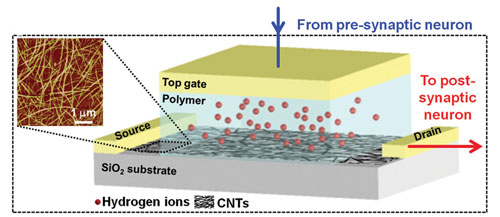| Posted: Feb 12, 2013 | |
A carbon nanotube synapse with dynamic logic and learning |
|
| (Nanowerk Spotlight) The human brain is composed of neuronal networks connected by about 1 quadrillion (1015) synapses. As inconceivably large as this number sounds, researchers are nevertheless laying the foundations for what is called neuromorphic engineering – a new interdisciplinary discipline that includes nanotechnologies and whose goal is to design artificial neural systems with physical architectures similar to biological nervous systems (read more: "Nanotechnology's road to artificial brains"). | |
| Carbon nanotubes, like the nervous cells of our brain, are excellent electrical signal conductors and can form intimate mechanical contacts with cellular membranes, thereby establishing a functional link to neuronal structures. There is a growing body of research on using nanomaterials in neural engineering (see our Nanowerk Spotlight: "Nanotechnology to repair the brain"). | |
| Carbon nanotube (CNT) synapse circuits are a first step in this direction (read more: "Researchers create functioning synapse using carbon nanotubes"). In new work, researchers at the University of California, Los Angeles, led by Prof. Yong Chen at the California NanoSystems Institute, have developed a CNT synapse with the elementary dynamic logic, learning, and memory functions of a biological synapse. | |
| Reporting their work in a recent issue of Advanced Materials ("A Carbon Nanotube Synapse with Dynamic Logic and Learning"), the team demonstrates a CNT synapse that is operated based on the dynamic interactions between CNTs and hydrogen ions in an electrochemical cell integrated in the CNT synapse. | |
 |
|
| The structure of a carbon nanotube synapse. a) A schematic diagram showing the transistor-like structure of a CNT synapse with an electrochemical cell containing hydrogen ions in a polymer electrolyte integrated in its gate. The inset is an AFM image of a random CNT network. The average density of the single-wall CNTs is ∼8/µm2 , and the average density of the CNT bundles is ∼2/µm2 . (Reprinted with permission from Wiley-VCH Verlag) | |
| The researchers point out that this CNT synapse consumes extremely low energy (∼7.5 pJ/spike), and the energy consumption could be significantly reduced further by scaling down the device. | |
| These CNT synapses could be integrated in a large-scale circuit to emulate the massively parallel signal processing and learning functions of a biological neural network for speech recognition, pattern recognition, statistic inference, and other intelligent behaviors. | |
| To fabricate the CNT synapse with a transistor-like structure, the team first coated a randomly aligned network of single-walled carbon nanotubes onto the surface of a silicon dioxide layer on a silicon chip. A 8µm by 30µm strip cut from this network was coated it with a 10nm titanium and 50nm gold layer to form the source and drain electrodes. A 90nm thick layer of polyether compound (PEG) was spin-coated and cross-linked on the top of the CNT network using electron-beam (e-beam) lithography, and a 15nm thick titanium layer and an 85nm thick aluminum layer were deposited onto the top of the PEG layer as a gate electrode. The final step was integrating an electrochemical cell in the transistor gate by sandwiching the hydrogen-doped PEG electrolyte between the CNT channel and the Ti/Al gate electrode. | |
| The researchers tested their CNT synapse under conditions similar to a biological synapse in a customized electronic circuit. Long-term synaptic plasticity has been realized as the underlying mechanism for learning and memory in the brain. The long-term plasticity behavior of the CNT synapse was demonstrated by modifying the synaptic strength with pre- and post-synaptic spikes. | |
| The team also notes that the synaptic strength in a CNT synapse can be continuously and reversibly modified to desired analog values by applying a series of pre- and post-synaptic spikes with different amplitudes. | |
 By
Michael
Berger
– Michael is author of three books by the Royal Society of Chemistry:
Nano-Society: Pushing the Boundaries of Technology,
Nanotechnology: The Future is Tiny, and
Nanoengineering: The Skills and Tools Making Technology Invisible
Copyright ©
Nanowerk LLC
By
Michael
Berger
– Michael is author of three books by the Royal Society of Chemistry:
Nano-Society: Pushing the Boundaries of Technology,
Nanotechnology: The Future is Tiny, and
Nanoengineering: The Skills and Tools Making Technology Invisible
Copyright ©
Nanowerk LLC
|
|
|
Become a Spotlight guest author! Join our large and growing group of guest contributors. Have you just published a scientific paper or have other exciting developments to share with the nanotechnology community? Here is how to publish on nanowerk.com. |
|
